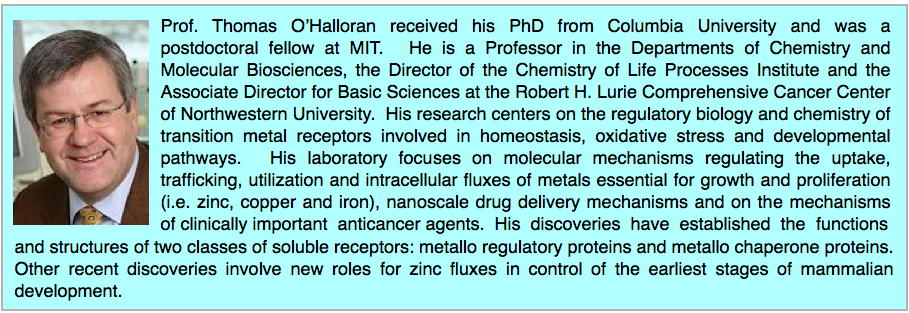
Thomas O'Halloran (Molecular Biosciences, The Chemistry of Life Processes Institute, Northwestern University, Chicago, USA)
Abstract:Living organisms acquire a variety of transition metal ions and concentrate them to precise levels. Specific cellular machinery maintains a different intracellular quota for each metal within a narrow range. The ensemble of metal concentrations is then referred to as the metallome of the cell. As the nature of the metallome is revealed for different types of cells, we are finding a general pattern of metal ion utilization that is highly conserved across evolution; however, specialized cells exhibit unique transition metal signatures that suggest specific functions. These patterns of metal utilization are perturbed in the earliest stage of mammalian developmental states, in infectious and neurological diseases and cancer cell proliferation. While most of these intracellular metals are bound tightly in a variety of well characterized metalloenzyme active sites, recent studies of the emerging class of metal trafficking proteins reveal new types of biological coordination chemistry and are opening new questions about how specialized cells acquire, deploy and store these metal ions. Recently we demonstrated that zinc influx and efflux controls meiotic progression in mammalian oocytes. We have shown that total zinc levels in mouse oocytes are more than an order of magnitude higher than copper or iron, and undergo dramatic fluxes during oocyte maturation, increasing by over 50& between GV and MII. Limiting intracellular zinc availability during in vitro maturation using pharmacological means causes formation of large polar bodies and arrest at telophase-I. I will discuss various mechanisms by which zinc fluxes regulate meiotic progression. A variety of single cell analytical methods including STEM-EDS/EELS, X-ray fluorescence microscopy and new fluorescent zinc-specific probes, allow for a comparison between the subcellular distribution of both total zinc and chelator-accessible zinc pools, and thus provide insights into intracellular speciation.
Contributors: Emily Que, Miranda L. Bernhardt, Betty Y. Kong, Alison M. Kim, Teresa K. Woodruff, Thomas V. O'Halloran
[1] Kim AM, Vogt S, O'Halloran TV, Woodruff TK, Zinc availability regulates exit from meiosis in maturing mammalian oocytes, Nat Chem Biol. 2010;6(9):674-81. PMCID: 2924620
[2] Bernhardt ML, Kim AM, O'Halloran TV, Woodruff TK, Zinc requirement during meiosis I-meiosis II transition in mouse oocytes is independent of the MOS-MAPK pathway, Biol Reprod. 2011;84(3):526-36. PMCID: 3043131.
[3] Kim AM, Bernhardt ML, Kong BY, Ahn RW, Vogt S, Woodruff TK, O'Halloran TV, Zinc sparks are triggered by fertilization and facilitate cell cycle resumption in mammalian eggs, ACS Chem Biol. 2011 Jul 15;6(7):716-23. Epub 2011 Apr 28. NIHMS: 292762.
